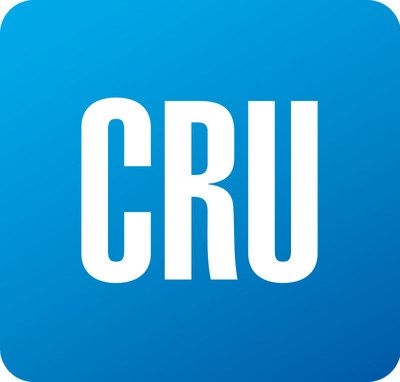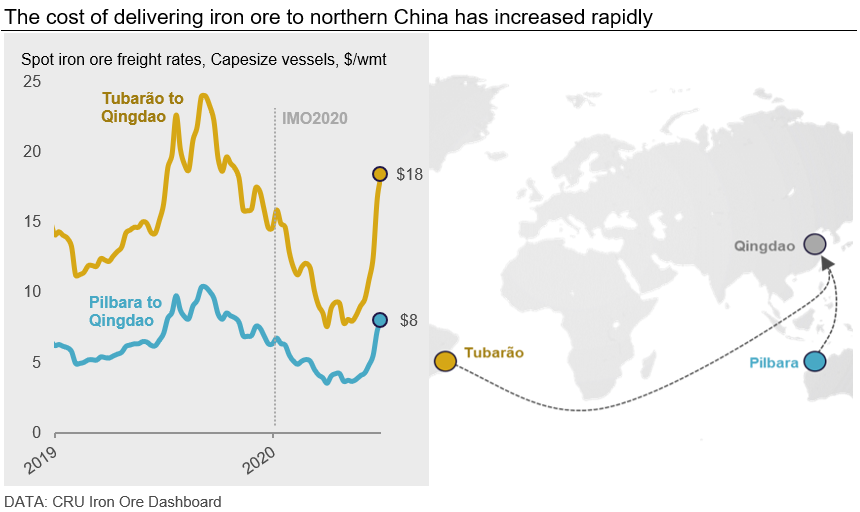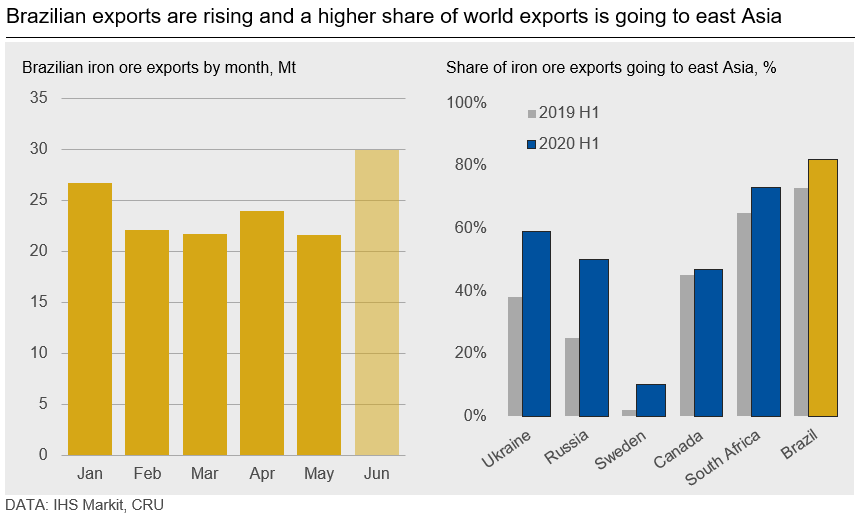Steel Products Prices North America

CRU: What’s Behind the Surge in Freight Rates?
Written by Erik Hedborg
July 7, 2020
By CRU Senior Analyst Erik Hedborg and Prices Analyst Rory Knight
In the past four weeks, freight rates have nearly doubled as Brazilian iron ore shipments have increased while an increasing proportion of global exports are being shipped to distant markets, reducing fleet availability. This is benefiting European steelmakers, while hurting iron ore miners, particularly fines and pellet feed producers.
Freight Rates Doubling in One Month
Having reached record lows in 2020 Q2, dry bulk freight rates rose in an extraordinary fashion in June. While bunker fuel prices have risen somewhat on higher oil prices, the surge is primarily driven by a sharp increase in time charter rates. Leading the charge is the Capesize market that is returning to 2019 Q3 levels as iron ore supply improves and vessel supply tightens.

Capesize Demand Surging on Brazilian Recovery
Capesize freight rates turned the tide at end-May with vessel supply tightening as Brazilian iron ore exports picked up. Compounding the supply situation was Australia’s continued iron ore export strength in the lead up to their financial year-end in June, which has resulted in strong vessel demand in the Pacific region. Moreover, vessels have been employed for longer voyages this year as “tonne mile” demand has increased due to iron ore miners in the Atlantic basin diverting some of their cargoes from the shorter Europe voyage to east Asia. This is in response to weak demand in Europe, where substantial cuts have been made to BF capacity utilization. China has readily absorbed the increased imports as steel production has rebounded strongly in Q2 and, consequently, their iron ore inventories have been stretched in recent months.
With more iron ore already being shipped over longer distances, rising Brazilian exports in June coupled with Vale reaffirming their production guidance for the year has triggered the sharp increase in both physical and paper freight markets. This has led to a sudden rise in Capesize demand in the Atlantic region at a time when most vessels were employed in the Pacific.

In addition to stronger vessel demand, Capesize vessel supply has tightened in the first half of this year. Covid-19 lockdowns in Asia caused significant newbuild slippage in the first few months of the year. Meanwhile, record low charter rates, which were well below opex for many vessels, prompted the scrapping of older ships, including some very large ore carriers (VLOCs). Slippage and scrapping were more acute for Capesize vessels than for other bulk carriers because Capesize earnings in 2020 H1 were particularly low—that vessel class is more reliant on iron ore than other vessel classes, for example Panamax or Supramax.
Q3 is a seasonally strong quarter for the dry bulk market as smaller vessels benefit from strong grain supply in the Atlantic market and, with weather-related disruption risk low at this time of year, Capesize ships benefit from stable iron ore and coal supply. Downside risks remain, however, with a slowing inventory drawdown in China on the demand side and net growth in the fleet as an increasing number of ships are scheduled for delivery in Q3 and Q4.
Pellet Feed and Fines Producers More Affected
This recent surge in freight rates has occurred as the 62% Fe fines, CFR China price has fallen off its peak of $105 /dmt. That means iron ore prices on an FOB basis, after a netback calculation, have been declining even faster. This reflects recent market dynamics with stronger shipments from Brazil, Australia, Peru and higher arrivals at Chinese ports.
Higher freight rates disproportionally affect fines and pellet feed exporters, as those products typically have high moisture levels (i.e. 8-12 percent), meaning the vessels are laden with more water per unit of iron being transported compared with products such as pellet and lump with moisture levels in the 1-5 percent range. Also, low-grade fines exporters are more exposed as the cost of freight makes up an even higher share of the 58 percent Fe fines, CFR China price.
High freight rates give European steelmakers a competitive advantage since they buy iron ore on an “FOB Brazil” basis, effectively getting a discount from the larger freight differential between the Brazil-Europe and Brazil-Asia voyage routes.
CRU expects freight rates to come down from the current elevated levels as this surge is partly driven by short-term positional dynamics and we expect the Capesize fleet to continue to grow in H2.
Request more information about this topic.
Learn more about CRU’s services at www.crugroup.com
Erik Hedborg
Read more from Erik HedborgLatest in Steel Products Prices North America

SMU Price Ranges: Sheet and plate steady ahead of Independence Day
Sheet and plate prices were little changed in the shortened week ahead of Independence Day, according to SMU’s latest check of the market.

Nucor maintains plate prices, opens August order book
Nucor aims to keep plate prices flat again with the opening of its August order book.

Nucor CSP remains level at $900/ton
Nucor maintained its weekly list price for hot-rolled (HR) coil this week, following two consecutive increases.

Cliffs raises prices, seeks $950/ton for July spot HR
Cleveland-Cliffs plans to increase prices for hot-rolled (HR) coil to $950 per short ton (st) with the opening of its July spot order book. The Cleveland-based steelmaker said the price hike was effective immediately in a letter to customers dated Monday.

HRC vs. prime scrap spread widens in June
The price spread between HRC and prime scrap widened in June.
